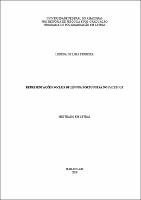| ???jsp.display-item.social.title??? |


|
Please use this identifier to cite or link to this item:
https://tede.ufam.edu.br/handle/tede/7767Full metadata record
| DC Field | Value | Language |
|---|---|---|
| dc.creator | Ferreira, Lorena de Lima | - |
| dc.creator.Lattes | http://lattes.cnpq.br/5827827957668633 | por |
| dc.contributor.advisor1 | Souza, Sérgio Augusto Freire de | - |
| dc.contributor.advisor1Lattes | http://lattes.cnpq.br/1010905812755398 | por |
| dc.contributor.referee1 | Rodrigues, Tatiana Belmonte dos Santos | - |
| dc.contributor.referee1Lattes | http://lattes.cnpq.br/6410934219970876 | por |
| dc.contributor.referee2 | Corrêa, Edith Santos | - |
| dc.contributor.referee2Lattes | http://lattes.cnpq.br/2831527202202996 | por |
| dc.date.issued | 2019-12-02 | - |
| dc.identifier.citation | FERREIRA, Lorena de Lima. Representações sociais de Língua Portuguesa no Facebook. 2019. 133 f. Dissertação (Mestrado em Letras) - Universidade Federal do Amazonas, Manaus, 2019. | por |
| dc.identifier.uri | https://tede.ufam.edu.br/handle/tede/7767 | - |
| dc.description.resumo | Esta pesquisa trata das Representações Sociais de Língua Portuguesa em uma página da rede social Facebook chamada Língua Portuguesa (https://www.facebook.com/linguaportuguesa07/), destinada à discussão e divulgação do idioma português no Brasil, de modo a verificar como os conteúdos são expressos e discutidos a partir de postagens e, por conseguinte, comentários dos internautas. Como referencial teórico-metodológico, apoiamo-nos em estudos que contemplam o ciberespaço e cibercultura, (Lévy, 2003); na visão sociodiscursiva da linguagem (Bakhtin/Voloshinov, 1997); e na Teoria das Representações Sociais (Moscovici, 1978). Com viés qualitativo, esta proposta insere-se na “vertente mais recente da pesquisa linguística, que adota uma abordagem mais crítica dos dados da linguagem das novas mídias” (Barton & Lee, 2015), apoiada nos conceitos da sociologia e da ideologia linguística. Os procedimentos de análise basearam-se no dispositivo de interpretação de Spink (1994) e Crusoé (2004). A materialidade linguística, ou “rastros” (Recuero, 2009), corresponde a posts e comentários coletados por meio de captura de tela, tecla Print Screan (Prt Sc) e recortes de comentários. As Representações Sociais foram categorizadas em três dimensões: Cognitiva/Prática, Afetiva, e de Poder/Resistência. Para elaboração dos mapas, usamos o software Cmps Tools. Os resultados indicam uma forte presença da gramática normativa norteando as Representações Sociais, reverberando em expressões que oscilam entre orgulho, patriotismo, tristeza e humilhação ou ódio à língua materna, mas também há amor, afeto, saudade e posicionamento combativo frente às desigualdades sociais e ao preconceito linguístico | por |
| dc.description.abstract | This research deals with the Social Representations of the Portuguese Language on a page of the social network Facebook called the Portuguese Language (https://www.facebook.com/Portugueselanguage07/), aimed at discussing and disseminating the Portuguese language in Brazil, in order to examine how the contents are expressed and discussed based on posts and, therefore, comments by internet users. As a theoretical-methodological framework, we rely on studies that contemplate cyberspace and cyberculture, (Lévy, 2003); in the sociodiscursive view of language (Bakhtin / Voloshinov, 1997); and in the Theory of Social Representations (Moscovici, 1978). With a qualitative bias, this proposal is part of the “most recent aspect of linguistic research, which adopts a more critical approach to the language data of new media” (Barton & Lee, 2015), supported by the concepts of sociology and linguistic ideology. The analysis procedures were based on the interpretation device of Spink (1994) and Crusoé (2004). The linguistic materiality, or “trails” (Recuero, 2009), corresponds to posts and comments collected through screen capture, Print Screan key (Prt Sc) and comment clippings. Social Representations were categorized into three dimensions: cognitive/practical, affective, and power/resistance. To prepare the maps, we use the Cmps software. The outcomes indicate a strong presence of normative grammar guiding Social Representations, reverberating in expressions that oscillate between pride, patriotism, sadness and humiliation or hatred to the mother tongue, but there is also love, affection, longing and combative stance in the face of social inequalities and linguistic prejudice. | por |
| dc.format | application/pdf | * |
| dc.thumbnail.url | https://tede.ufam.edu.br//retrieve/38504/Disserta%c3%a7%c3%a3o_LorenaFerreira_PPGL.pdf.jpg | * |
| dc.language | por | por |
| dc.publisher | Universidade Federal do Amazonas | por |
| dc.publisher.department | Faculdade de Letras | por |
| dc.publisher.country | Brasil | por |
| dc.publisher.initials | UFAM | por |
| dc.publisher.program | Programa de Pós-graduação em Letras | por |
| dc.rights | Acesso Aberto | por |
| dc.subject | Língua portuguesa | por |
| dc.subject | Facebook (Rede social on-line) | por |
| dc.subject | Linguística | por |
| dc.subject | Representações sociais | por |
| dc.subject | Língua portuguesa - Conversação e frases | por |
| dc.subject.cnpq | LINGUÍSTICA, LETRAS E ARTES | por |
| dc.title | Representações sociais de Língua Portuguesa no Facebook | por |
| dc.type | Dissertação | por |
| dc.subject.user | Língua Portuguesa | por |
| dc.subject.user | Representações Sociais | por |
| dc.subject.user | por | |
| dc.subject.user | Linguística | por |
| Appears in Collections: | Mestrado em Letras | |
Files in This Item:
| File | Description | Size | Format | |
|---|---|---|---|---|
| Dissertação_LorenaFerreira_PPGL.pdf | Dissertação_LorenaFerreira_PPGL | 5.91 MB | Adobe PDF |  Download/Open Preview |
Items in DSpace are protected by copyright, with all rights reserved, unless otherwise indicated.




